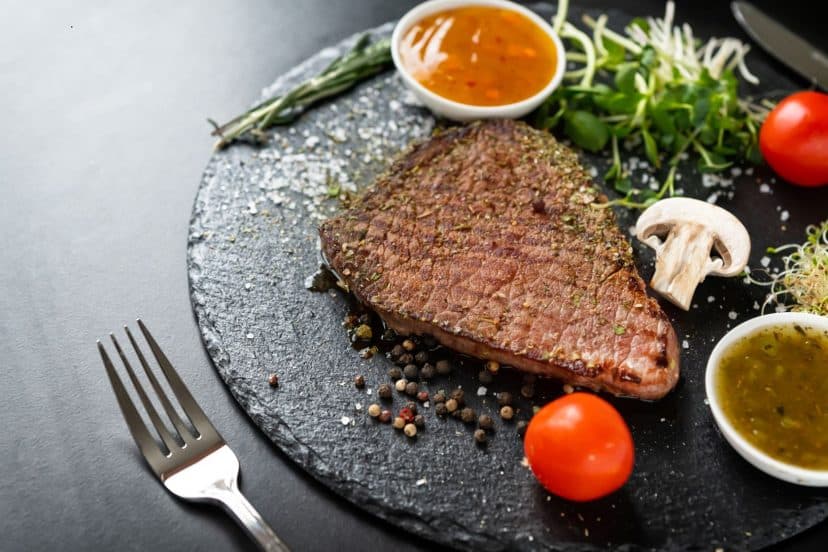CookASteak – A tender, juicy steak is one of life’s great pleasures. While there are plenty of factors that determine how tender your steak turns out, the cooking method and preparation you use can make all the difference. With the right techniques, you can turn even the toughest cuts of beef into fork-tender masterpieces. Wondering, how can I make my steak tender?
In this comprehensive guide, we’ll walk through all the tips, tricks, and techniques you need to know to make your steak mouthwateringly tender every time. We’ll cover everything from choosing the right cut of meat, proper seasoning and marinating, cooking methods and doneness levels, resting, slicing against the grain, and more.
Follow these simple steps, and you’ll never have to contend with a chewy, tough steak again.
Choose the Right Cut
The first step to tender steak begins with choosing the right cut of beef. When it comes to tenderness, not all steaks are created equal. Here are some of the most popular cuts, ranked from most tender to least:
Filet Mignon
This lean, elegant cut comes from the tenderloin, the most unused muscle on the cow. Filet mignon offers supreme tenderness and melt-in-your-mouth texture but lacks some of the fat and flavor of other cuts.
Ribeye
Cut from the rib section, the marbling on a ribeye makes it exceptionally flavorful, juicy and tender. The generous fat content gives it a buttery, rich taste.
New York Strip
Also known as a shell steak, this moderately tender cut is a steakhouse favorite. It has good marbling which keeps it juicy during cooking.
Sirloin
Taken from the hip and rear of the cow, sirloin offers good value for more budget-conscious consumers. Look for top sirloin if you want maximum tenderness.
Flank Steak
This thin, flat cut needs special care to tenderize but rewards the effort with a robust, beefy flavor. It does best with marinades.
Skirt Steak
Cut from the diaphragm muscle, skirt steak has tremendous flavor. But it can quickly go from tender to tough if overcooked.
Brisket
The breast area of the cow produces flavorful brisket, but it needs prolonged cooking to break down the tough connective tissues. For the most tender results, choose cuts from the loin or rib primal cuts, like filet mignon, ribeye, New York strip, or tenderloin.
Also look for good marbling, which provides internal fat and bastes the meat during cooking. While cheaper cuts can be tender and tasty with the right prep, you’ll get more consistently tender steaks from the naturally more tender (and more expensive) cuts.
Properly Season and Marinate
A flavorful marinade or spice rub not only adds layers of flavor to your steak but can also help break down tough tissues and fibers. Here are some top ways to season and marinate for tenderness:
- Salt – Sprinkling salt over your steaks at least 40 minutes before cooking allows the salt time to penetrate deep into the meat, dissolving some proteins to tenderize while enhancing flavor.
- Acidic marinades – Marinades made with acidic ingredients like vinegar, citrus, yogurt or wine help tenderize by chemically breaking down tough collagen in the meat. Let meat marinate 1-2 hours.
- Enzymatic marinades – Pineapple, papaya, ginger, and kiwi contain enzymes that further break down collagen. Marinate 1-2 hours.
- Spice rubs – Rubs with spices containing collagen-dissolving enzymes like paprika and ginger can boost tenderness. Let sit 40 minutes before cooking.
- Tenderizing tools – Handheld meat tenderizers, Jaccard tenderizers, or a mallet can mechanically break down tough connective tissue. Use judiciously to avoid tearing meat.
Whichever marinade or seasoning you use, resist over-marinating. Too long in an acidic marinade can start to chemically “cook” the meat, leaving it mushy. For best results, marinate just long enough to allow flavors to permeate and acids to work their tenderizing magic.
Know Your Cooking Methods
How you apply heat is one of the biggest determiners of a tender outcome. Here are some of the best cooking methods for keeping steaks tender:
Grill
The high, dry heat of the grill is ideal for getting a flavorful sear to lock in juices. Avoid charring completely. Combine direct and indirect heat by searing over direct heat, then moving to indirect heat to cook through.
Pan Sear
Get an evenly browned crust by heating just enough oil to coat the pan. Let steak rest before slicing. Deglaze the pan to make a flavorful sauce.
Broil
Broiling’s intense overhead heat helps develop a nice crust. Watch meat closely to avoid overcooking.
Roast
For uniform doneness edge to edge, first sear meat on the stovetop, then finish cooking in a hot oven.
Sous Vide
This hands-off cooking method uses precise, low-temperature water baths for guaranteed tender results and no overcooking.
Braise
For tough cuts like brisket, low, moist braising helps break down collagen for fall-apart tenderness. Avoid boiling, deep frying, or cooking with too much liquid, as these techniques can make meat dry, tough, and rubbery. Pay close attention to temperature guides for your chosen cooking method so steaks finish tender, not well done.
Know Your Doneness Levels
Cooking steak to the right doneness is imperative for a tender bite. Here are the stages of doneness and what to look for:
- Rare – Cool, bright red center. Soft, juicy texture. Pull at 125°F for pan searing.
- Medium rare – Warm, pink center. Firmer but still tender and juicy. Pull between 130-135°F.
- Medium – Hot, light pink center. Firm, with moderate juiciness. Pull between 135-145°F.
- Medium well – Thin line of pink. Dense, drier texture. Pull between 145-155°F.
- Well done – No pink. Dry, tougher meat. Pull between 155-165°F.
For your best shot at tenderness, cook steaks no further than medium. The higher temperatures required to cook well done destroy moisture, texture, and collagen that keeps steak tender. Use an instant-read thermometer to eliminate guesswork.
Let Your Steak Rest
After all your hard work, don’t ruin your masterpiece by immediately slicing into the cooked steak. Letting it rest allows juices and collagen that have been weakened during cooking to redistribute throughout the meat. This makes the steak juicier, more tender, and less likely to spill precious juices onto the cutting board.
Give steaks at least 5 minutes of resting time, up to 10-15 minutes for thicker cuts. Tent them loosely with foil to keep them warm. The cooler temperature also allows for carryover cooking to finish without overcooking.
Slice Against the Grain
Even after following all these steps, improperly slicing can still leave you with chewy results. Look closely at the direction of the meat fibers, called the grain. Slicing against the grain shortens the muscle fibers, making chewing easier. If sliced with the grain, the long fibers are more likely to be chewy.
Conclusion
With the right cut, seasoning, cooking method, doneness, and slicing, you can enjoy the tenderest, juiciest steak imaginable. While getting perfect results takes practice, if you follow these guidelines for choosing, preparing, and cooking your steak, you’ll be sinking your teeth into tender perfection in no time. Trust the process, pay attention as you cook, and your patience will be rewarded with the steak of your dreams.

